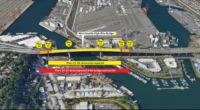Bid Process Begins for West Seattle Bridge Final Phase

West Seattle High-Rise Bridge has been closed for a year due to cracks. Photo courtesy of Seattle DOT
The city of Seattle has shifted from emergency stabilization of the cracked West Seattle High-Rise Bridge to preliminary design, and has put out a Request for Qualifications to bring a contractor on board during the design phase.
The Seattle Dept. of Transportation (SDOT) closed the 2,600-ft-long, 37-year-old high-rise bridge in March 2020 due to worsening cracking. Since then, Kraemer North America, hired under an emergency contract to stabilize the structure, injected epoxy into cracks, added external post-tensioning to support the existing internal post-tensioning system, wrapped concrete girders with carbon fiber-reinforced polymer and released the damaged bearing at Pier 18.
SDOT and WSP, which provided the engineering, monitored that stabilization across the changes in weather this winter and have finished about 30% of the next phase’s design. Bringing a contractor on board now will allow that firm to participate in finishing the design and construction of the rehabilitation measures with the goal to reopen the bridge to traffic in mid-2022.
“Our work to reopen the bridge is on track, and we’ve made great progress to date,” said Sam Zimbabwe, SDOT director, in a statement.
SDOT now says they’ve progressed far enough to estimate the total costs to rehabilitate both the High Bridge and the Low Bridge at about $72 million, $58 million for the high and $14 million for the low.
Using the alternative delivery method, SDOT plans to bring a contractor onto the project early in the timeline to work with the design team for schedule predictability. SDOT says shortlisted construction firms will be interviewed this spring.
“The bridge closure has had so many impacts on the residents and businesses of West Seattle, Georgetown and South Park,” said Jenny Durkan, Seattle mayor, in a statement. “We’re keeping pace with our aggressive schedule and taking another major step toward reopening the West Seattle High-Rise Bridge.”
Monitoring has shown that bridge stabilization performed as expected, even with a foot of snow on the bridge adding weight in February. SDOT expects the rehabilitation plan to use many of the same methods employed during the emergency stabilization. The preliminary design for the next phase includes additional post-tensioning cable and anchor systems and carbon-fiber wrapping across the central and side spans. Plans also call for reinforcing the soil near the Pier 18 foundation because of seismic concerns.
While work focuses on the 140-ft-high High-Rise Bridge, SDOT wants to take the opportunity to conduct preventative maintenance on the Low Bridge by injecting epoxy into cracks and adding carbon-fiber wrapping on both the interior and exterior concrete surfaces of the swing spans. Other improvements include a controls system upgrade and refurbishment of the hydraulic cylinders that help the bridge swing open. Both bridges will be in the same contract to improve efficiency in coordination and scheduling, SDOT says.



